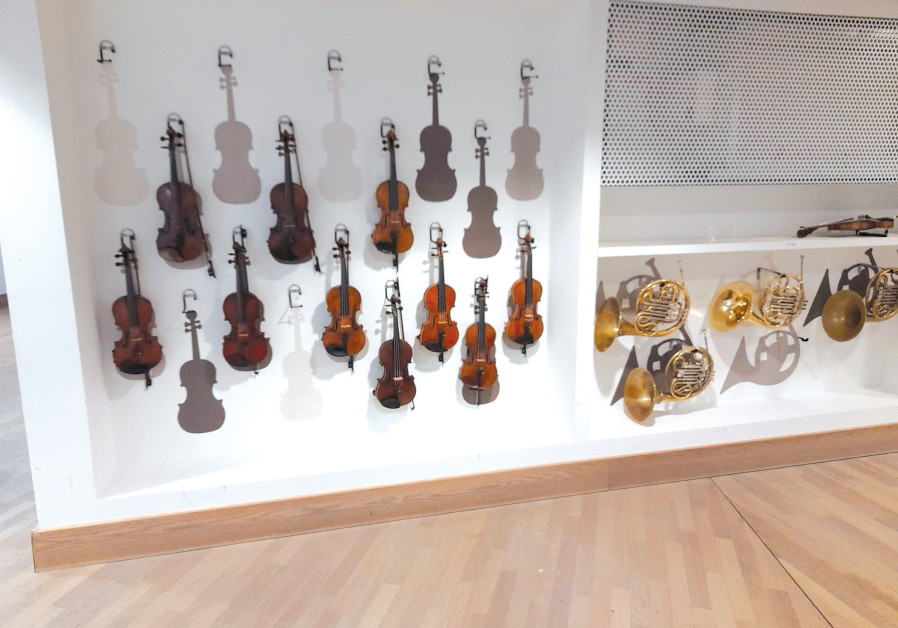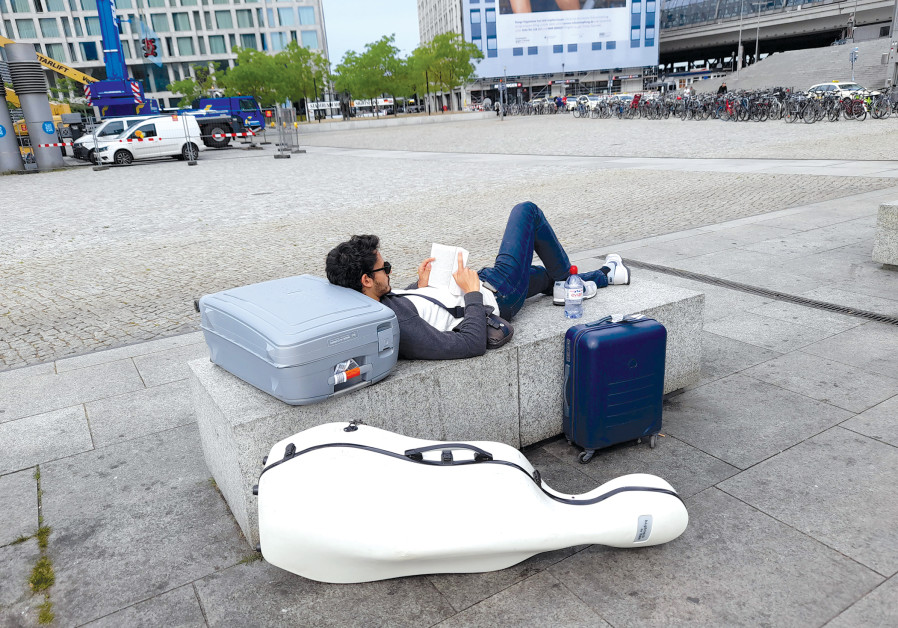The big deal here is that none of the above has happened outside these shores for what feels like eons, in other words, before the pandemic hit the global political and social distancing fan.
I was fortunate enough to tag along with the JSO on its recent five-date tour of Germany, taking in concerts in Hamburg, Berlin and Bochum. The local audiences, starved of live musical entertainment for so long, were more than a little enthused by the arrival of the Israeli orchestra. And, while the auditoria were far from packed to the rafters = coronavirus restrictions currently limit attendance to a third of capacity – what they lacked in quantity they certainly made up for in terms of raucous and very animated appreciation of the efforts of the 70-plus instrumentalists and conductor-musical director Stephen Sloane.
The performance at the Konzerthaus in Berlin had Sloane traipsing on and off the stage to acknowledge the audience’s wild clapping and foot stamping a full six times. Evergreen Georgian-born Austrian pianist Elisabeth Leonskaja did several similar trips herself in the wake of her scintillating solo spot in Beethoven’s Piano Concerto no. 4. Both did their fair share of post-concert toing and froing wherever the JSO did roam on the three-city circuit. Leonskaja was even moved to perform a solo encore, following her final slot on the excursion, in Bochum, producing an emotive and dazzling rendition of Debussy’s Prelude no. 24. That, too, elicited another decibel-saturated audience response.
Touring and performing at different locations, bring with them all sorts of vantage points – personal and professional alike – challenges and joys. Take, for example, the contrasting aesthetics, historical baggage and acoustics of the Elbphilharmonie auditorium in Hamburg – known locally, as my cab driver informed me, as the Elphie – and the hall in Berlin. The former is a state-of-the-art contemporary architectural creation that, from the outside, resembles some kind of weird and wonderful futuristic wavy glass-and-crystal iceberg sitting atop an old redbrick warehouse building. Opened in January 2017, it cost a cool 866 million euros, coming in at almost four times the original budget. Meanwhile, the second JSO stop was at the venerated Konzerthaus Berlin, a neoclassical edifice complete with pillars, gilded fixtures and fittings and voluminous chandeliers, which is currently marking its bicentennial.

THERE WAS a buzz in the air from the start, as the dozens of orchestra members rendezvoused in the initial security check line at Ben-Gurion Airport. The musicians had rehearsed together as much as they could between the pandemic lockdowns and, in fact, performed the four works that comprised the majority of the German dates just the day before departure, although with a different soloist for the Beethoven concerto. But this was something else. This was about getting back on the road, flying, busing and taking trains, checking in and out of hotels, and hopefully finding some free time to catch some of the local sights and energies betwixt rehearsals and concerts.
The JSO tour, the first foray to foreign climes by an Israeli orchestra since the world was turned on its head, was well and truly underway.
There were all sorts of COVID-requirement to-dos but we all managed to get past the first hurdle and eventually made it to our plane. It is not pleasant in the best of circumstances to sit around with a mask inhaling one’s own breath and, of course, bacteria but we survived both flights, which got us to our first port of call, Hamburg, via Frankfurt.
While it was great to step out into foreign climes, the weather left a lot to be desired, at least initially. Having left the environs of Jerusalem basking in a comfortable 26 degrees we were thrust into a 34-degree furnace in Hamburg. But, northern Europe being northern Europe, within a couple of days that subsided to a delightfully manageable 27 degrees.

THE DAY after our arrival, the ensemble had its first rehearsal, at the grandly appointed Mozartsaal. Cello, double bass, violin, viola and other cases were unloaded from the bus that brought us over from the hotel, and the JSO lads and lasses made their way into the grand high-ceilinged rehearsal space. The anticipatory buzz quickly became a highly audible din as French horns, trumpets, trombones, cellos, violins and all manner of other wind and string instruments seemingly did their best to outdo each other in the decibel stakes. Still, it was proverbial music to my ears, and I reveled in the behind-the-scenes classical cacophony as the musicians blew, plucked and tweaked before Maestro Sloane arrived, baton at the ready.
Before the run-through began in earnest, the ensemble was addressed by Karsten Witt, Sloane’s manager and a local classical music scene mover and shaker who organized the JSO tour through his CLSX.de nonprofit. Witt talked about the hard work and optimism that went into making the trip a reality, which, in fact, was not a done thing until just a few weeks before liftoff. Witt received a deserved round of applause from one and all. As did Ms. Leonskaja as she took her place at the piano for a rehearsal of the Beethoven piece. It was, at once, evident that the sprightly 75-year-old pianist has been around the concert hall block a couple of times, and both she and the members of the ensemble were clearly delighted to be doing business together.
By all accounts the program was a richly varied offering that made for entertaining, moving and intriguing listening, and was deftly delivered by an orchestra at the top of its game. When we met up backstage after the Berlin concert, a tired but elated-looking Sloane shook my hand warmly and commented, somewhat superfluously: “This orchestra is just so good, so good.” I could not help but agree.
Leonskaja’s contribution certainly helped matters. Her rendition exuded a sense of impish fun while delivering all the requisite gravitas, with seeming insouciance.
THE INTRODUCTORY remarks that preceded all the live concerts helped to engender a relaxed ambiance. That was felt keenly at the Konzerthaus Berlin when, at the end of his entertaining address, former Bundestag president Norbert Lammert informed us we could all remove our masks. Smiles and sighs of relief all round. For those of very short memory spans, when we left for Germany in mid-June wearing masks indoors was no longer mandatory here, hence returning to that requirement, in Germany, was more than a little irksome.
That onerous facet of the trip was compounded by the orchestra members having to undergo PCR tests – often administered none too gently – every two to three days, to make sure they were “kosher” to take the stage. Thankfully, as a mere audience member I could make do with the Schnelltest – rapid test – which was a less invasive procedure. Mind you, a couple of days before we returned home I joined the PCR test crowd, which covered us for the final concerts, in Bochum, and the flight back to Ben-Gurion.
At first glance, Bochum appeared to be an unexciting grey-looking town with nothing outstanding going for it, especially after our three-day sojourn in Berlin. However, betwixt rehearsals and concerts, I discovered some charming parks – replete with duck- and geese-filled ponds – churches and green other spots, and record stores, and gradually took the town to my heart.
The first concert there was an emotive affair for Sloane, who was bringing the curtain down on a 27-year stint as music director of the Bochum Symphony. As we were ferried between the hotel and various venues we espied street posters with a picture of the conductor caught in mid-baton swing, and with the caption: “27 years with you and the Bochum Symphony. Thank you very much for that.”
It had been a long and fruitful love affair between Sloane and the Bochum ensemble, with the conductor also serving as one of the driving forces behind the design and construction of the orchestra’s impressive home base, the Anneliese Brost Musikforum Ruhr. Prior to the last run out of the four-work program, head of the 2021 Ruhr Piano Festival Prof. Franz Xaver Ohnesorg thanked Sloane for his sterling work and noted that the JSO’s visit was particularly poignant as it coincided with the 1,700th anniversary of the arrival of Jews in Germany.

YES, AS many times as I have visited Germany or Austria over the years, those countries’ dark not-that-distant past is never far away for me. That came across most palpably as I encountered the leviathan Holocaust Memorial in Berlin, with its graveyard-like design. There I met a police officer on a motorcycle stationed at one corner of the site. When I asked him if it was, indeed, the Holocaust Memorial he confirmed it was. When I remarked that my grandparents, uncle and aunt all perished in Auschwitz his dark helmet visor came up and he looked moved, if not shaken. That, and a brief encounter with a genial 40-something teacher in Hamburg called Marcus who said that, while he was not personally guilty for the Holocaust, “we are all responsible for the deeds of the previous generations,” provided some heartwarming respite from the cloud that is never far away when I hear German spoken.
As I moseyed over to the pretty ludicrous reconstruction of Checkpoint Charlie, the legendary crossing point between East and West Berlin back in the day, through which I passed in 1986, I caught site of a stretch of the gray sober-looking concrete Berlin Wall still bearing some of the polychromic graffiti that adorned the west-facing side back in the day. That side, it transpired, is also where the Gestapo and SS headquarters were located.
The Topography of Terror is an outdoor and indoor history museum, located above the site, chronicling some of the racism crimes committed in Berlin during the Nazi regime of 1933-45. The German and English texts that went with the alfresco Between Propaganda and Terror exhibition shed light on the chilling events of the times, and the photographs and document facsimiles convey the spirit of the day only too clearly. There was, however, one surprising ray of light among the familiar images of cackling German soldiers, policemen and citizens, as Hitler’s henchmen wreaked havoc on the property of Jews and other “undesirables.” One brave Jewish storekeeper put up a notice on his display window, around the time of Kristallnacht, fearlessly proclaiming: “I am Jewish. Aryans enter my shop at their own risk!”

THE FINAL concert of the tour was an altogether other experience. For starters, it was a streamed performance that comprised a rendition of Mahler’s Symphony no. 2, which was written at the end of the 19th century and became one his most popular works. The physical setting for the concert was radically different from the historical grandeur of the Konzerthaus Berlin and the state-of-the-art design and acoustics of the Hamburg and Bochum halls.
The tour finale took place at the Jahrhunderthalle Bochum, which was originally built in 1902 for the Düsseldorf trade exhibition. It was subsequently converted into a gas power station. The décor, today, is a fetching oxymoronic mix of the detritus of the hangar-sized structure’s industrial past, with its current function as a cultural center reflected in the polished concrete flooring, black roof-to-floor length sound curtains and various fittings that facilitate rapid adaptation for a range of artistic events.
For the occasion the JSO’s ranks were swelled by members of the Bochum Symphony, with the full instrumental personnel boosted to over 100. The players’ lineup was complemented by soloists Israeli soprano Hila Baggio and Austrian mezzo soprano Elisabeth Kulman, and the 70-strong Berlin Radio Choir. It was quite a showing in the cavernous setting witnessed, in situ, by a small cast of local VIPS – and Yours Truly.
It was a fittingly stirring end to the eventful tour on which I got to know some of the orchestra members quite well, and enjoyed their sense of camaraderie, and their deft seasoned musicianship.
